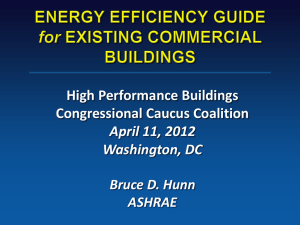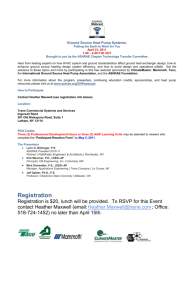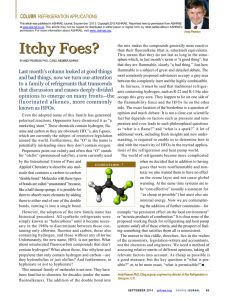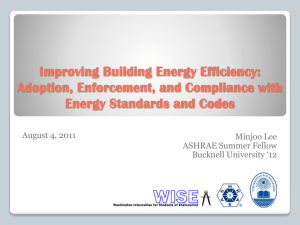Identify Potential Energy Saving Measures for Existing Buildings
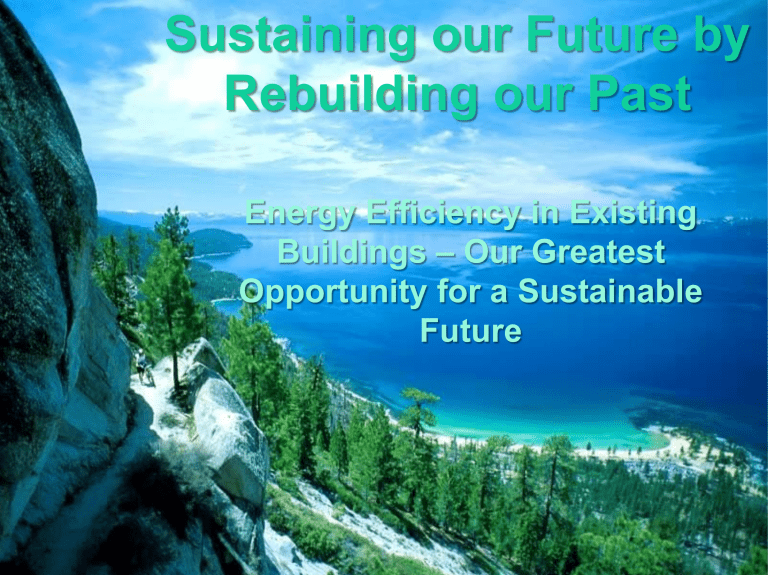
Sustaining our Future by
Rebuilding our Past
Energy Efficiency in Existing
Buildings – Our Greatest
Opportunity for a Sustainable
Future
ASHRAE’s Sustainability Goals
The Path Towards Net Zero Energy
Buildings
Resolving the Issues of Increasing
Demand, Decreasing Supply and
Environmental Impact.
ASHRAE Sustainability Initiatives
ASHRAE is working hard in a wide range of areas to support the goals of sustainability for reduction in energy use and green house gas emissions.
• 2006 Strategic Plan
• Green Guide 2nd Edition
• Sustainability Roadmap
• Vision 2020 Report – NZEB goals
• Building Performance Metrics Projects
• ASHRAE Building Energy Labeling Program
• Educational, Certification & Research Programs www.ashrae.org
Total Energy Consumption
www.highperformance
buildings.gov
Buildings Consume
40% of US Primary Energy
Buildings Represent
• 17% of fresh water consumption
• 25% of wood consumption
• 33% of CO2 emissions
• 30% of waste generation
• 40% of energy use
• 55% of natural gas use
• 72% of electrical energy use
PER CAPITA ENERGY
CONSUMPTION
Worldwide Average 200 Kwh/capita/year
India
China
450 Kwh/ca[pita/year
1800 Kwh/capita/year
Argentina/Brazil 2,200 Kwh/capita/year
Europe 6,000 Kwh/capita/year
Kuwait 13,600 Kwh/capita/year
USA 16,000 Kwh/capita/year
Available Data Bases for
Commercial Buildings
Energy Information Agency under US Department of Energy
Commercial Building Energy Consumption
Survey – CBECS www.eia
.doe.gov/emeu /cbecs
Whole Building Design Guide www.wbdg.org
Driven by the relentless growth in human population and in individual consumption, our global footprint now exceeds the world’s capacity to regenerate (itself) by about 30%
James P. Leape – Director General World Wide Fund for Nature
Why Are We Here?
USA Energy
Production and Imports
1975 2005 2030
Oil 70%/30% 30%/70% ???
Gas 100% 70%/30% ???
Global warming
IPCC - Intergovernmental Panel Global warming
Climate Change
The true rise of sea level might be as great as several meters by 2010
A record heat wave scorched Europe in August
2003, claiming an estimated 35.000 lives.
In France alone, 14.802 people died from the searing temperatures— more than 19 times the death toll from the SARS epidemic worldwide.
In the worst heat spell in decades, temperatures in
France soared to 104 degrees Fahrenheit (40 degrees Celsius) and remained unusually high for two weeks.
Pre-industrial: 180 - 280 PPM
2007: 380 PPM
2050 Business as usual: 580 PPM
Can we afford to take a chance?
World: 4.3 Metric tons/person
OECD Nations: 11 Metric tons/person
USA: 19 Metric tons/person
Global CO2 Emissions
2009: 30 Billion metric tons
2030: 42 Billion metric tons
USA Copenhagen Commitment
17% Reduction by 2020
Previous Commitment
45% by 2030 80% by 2050
How do we achieve that without significantly raising energy prices?
What is the cost of taking energy out of buildings?
Estimated clean energy annual investment
WEO 2008 550 ppm - $380 Billion per year
WEO 2008 450 ppm - $542 Billion per year
G I - $450 - $600 Billion per year until 2030
McKinsey - Energy Efficiency - $170 Billion per year in the USA
Offering 17% ROI Saving 9.3 Quads/yr
(23%) by 2020
McKinsey Global Institute
Green Investing - 2009 World Economic Forum
Our Greatest Opportunities?
2% of Building Projects are New
Construction
86% of Construction Dollars go into
Existing Buildings
75% to 80% of All Buildings
That will Exist in 203 0
Exist Today!
Our Greatest Opportunities
Existing Buildings
Barriers To Success
1. Legislative/ Political
2. Economic
3. Technical
4. Cultural
5. Societal
Our Greatest Opportunities
Existing Buildings
Energy
Efficiency in
Existing
Buildings
What Have We
Learned?
ASHRAE –
Cohesive Program to Promote Energy
Efficiency in
Existing Buildings
• Standards
• Guidelines
• Design Guides
• Design Manuals
• Handbooks
• Educational
Programs
Sustainable Buildings
Initial Construction Cost is only 2%
In the Life Cycle of a Building
Operational and Energy Cost is only 6%
Initial Construction Cost is only 2%
Occupancy Cost Accounts for 92%
Operational and Energy Cost is only 6%
Occupancy Cost Accounts for 92%
Energy Policy Act - EPAC 2005
Energy Independence and Security Act - EISA
2007
American Clean Energy and Security Act
ACES 2009?????
Tax Incentive & Assistance Program - TIAP
American Recovery and Reinvestment Act –
ARRA www.dsireusa.org
Energy Independence and Security Act of 2007
(EISA) requires new federal buildings to reduce their fossil fuel based energy use by 55% by 2010 and to zero by 2030.
EPAC 2005 / EISA 2007 Existing Federal Buildings 30% reduction in energy use by 2015
Co-Sponsors: ASHRAE, AIA, ACCA, GBI, ICC, IFMA, NFPA, NIBS,
USGBC and others
FEDERAL ENERGY LEGISLATION
HR 2454 AMERICAN CLEAN ENERGY AND SECURITY ACT – 2009
S.1462 Energy Bill & S.1733 CLIMATE CHANGE
30% Reduction in Energy by 2010
50% Reduction in Energy by 2016 Res & Com
Buildings which, on an annual basis, use no more energy than is provided by on-site renewable energy sources.
David JC MacKay, PhD
Physics Professor University of Cambridge
Sustainable Energy – without the hot air
Renewable Energy Sources in the UK
Source
On Shore Wind
Off Shore
Wind
Capacity Cost -
35 GW
20 GW
Yield per Cost Per
Billions Billion £ Person
£ 27 1.3 GW/£ £ 450
£ 36 0.8 GW/£ £ 650
£ 190 0.25 GW/£ £ 3200 Photo Voltaic
Farm
Waste
48 GW
3.0 GW
Incineration
Heat Pumps
Clean Coal
210 GW
8.0 GW
Nuclear Power 45 GW
£ 8.5
£ 60
£ 16
£ 60
0.35 GW/£
35 GW/£
0.5 GW/£
0.75 GW/£
£ 140
£ 1000
£ 270
£ 1000
Cost/Person
/GW
£12.8
£32.5
£66.6
£46.6
£4.75
£33.75
£22.2
1
2 cash flow
Lease Costs (or Finance Costs) utility bills
0
0%
Source Energy Savings (%)
100%
• Advanced Energy Design Guides
• Standard 90.1
• Standard 189.1
• Standard 100
• Commissioning and Retro Commissioning
• Operation and Maintenance Guidance
ASHRAE Sustainability
Initiatives
Advanced Energy Design Guides (AEDG)
30% Series –Retail, Office , K-12 Schools,
Warehouses , Highway Lodgings , - Already
Published
Health Care Facilities out shortly
ASHRAE AEDGs
If Every One of the 225,000 Downloads of the AEDGs
Resulted in Just One Project Being Designed at 30%
Saving
We Would Save:
115 Trillion Btu/Year
19.8 Million Tons CO2/Year
$1.30 Billion Per Year
Additional Advanced Energy Design
Guides Planned or In Process
Energy Efficiency Guides for Existing
Buildings
Business Case
Technical Guide
Owning and Operating Guide
• Complete the 30% Guide Series
• Complete the Existing Building Guide Series
• Develop the 50% and NZEB Design Guides
• Target completion of the 50% series is 2009-2011
• Target completion of the NEZB series is 2013-2015
• Consider Plug and Process Loads
• Evaluate use of Cost Based Site or Source EUIs
•
Develop the User’s Manual
• Consider Performance Based Analysis
• Complete and Publish the Standard in 2009
• Set a Clear Timeline to Get to Net Zero in 2030
•
Develop the User’s Manual
• Identify Application of Renewables in Dense Urban
Areas
Consider Two Tiers of Energy Performance
40
• Further develop the standard
• Include Energy Conservation Measures (ECMs)
• Include Life Cycle Cost Analysis techniques.
• Consider requirements to do Energy Modeling and Load Simulation
ASHRAE Energy Targets
ASHRAE ENERGY TARGETS
Year Standard Standard
90.1* 90.1 **
2004 43.75 70.70
2007 40.60
--
2010 30.6* 49.0 !
2013 27.0* 42.0 !
2020 18.0* 24.0 !
2025 14.0* 18.0 !
2030 10.0* 16.0 !
1#
--
Standard
33.1
28.2
24.7
2016 21.85* 35.35 !
18.0
12.6
6.30
Zero
189.1
2## 1#
AEDGs
###
2##
--
49.0
-
37.3
54.26
40.95
26.7
38.27
36.1
24.0
35.70
31.85
18.0
31.85
18.2
Zero Zero
9.10
Zero Zero
Zero Zero Zero
*
Excludes Plug and Process Loads ** Including Plug and Process Loads
#Targeted at 30% below Standard 90.1-2004 Excludes Plug and Process Loads
# #Targeted at 30% below Standard 90.1-2004 Includes Plug and Process Loads
### Targeted to be at 30% below Standard 90.1 for 2007-09 50% for 2009-11 and net zero 20013-15
36000
Energy Reduction Proposal r g
2010 2015 2020
Y e a r
2025 2030
ASHRAE BOD Goal
Identify Potential Energy Saving
Measures for Existing Buildings
Routine Maintenance and Repairs
Retro – Commissioning
Utility Tariffs/Negotiations
Tenant Fit Out and Improvements
Equipment Replacement
Major Renovations
Identify Potential Energy Saving Measures for Existing Buildings
Building Envelope Lighting Systems
Window Replacement T5 Versus T8/T12 Lamps
Solar Films Compact Fluorescent Bulbs
Caulking/Sealing
Enhanced Insulation
Electronic Ballasts
Day Lighting Controls
Motion Sensors
HVAC Systems
Higher Equip. Efficiencies
Heat Recovery
Displacement Ventilation
DOAS
GSHP
Controls/Other
Management Systems
Maintenance Systems
Monitoring/Auditing
Applied Photo Voltaics
Variable Speed Drives
Role of Commissioning and Retro Commissioning
Why is Cx or RCx so Critical ?
•
Buildings are very complex prototypical machines
• Unique
• Built on-site
• Built by hand
• Thousands of independent components
Most buildings do not operate as intended
ASHRAE Guidelines
ASHRAE Guideline 0-2005 ,
The Commissioning Process
Describes the commissioning process capable of verifying a facility and its systems meet the owner’s project requirements
ASHRAE Guideline 1-2007 ,
The HVAC Commissioning Process
Describes the technical requirements for the application of the commissioning process that will verify HVAC systems achieve the owner’s project requirements
• Complete the Work of the TRGs
• Provide Training through the Chapters
• Provide Educational Programs
• Provide Certification Programs
ASHRAE Sustainability
Initiatives
Integrated Building Design
IBD Manual of Practice
Building Information Modeling
BIM Guide
“SMART” Documents
Building Performance Metrics
Carbon Equivalency Based
ASHRAE Building Energy Labeling Program
ASHRAE Energy Labeling
Building eQ Program
2008 ASHRAE Environmental Guidelines for
Datacom Equipment
• Real Time Energy Consumption Measurement in Data Centers
• Particulate and Gaseous Contamination in Datacom Environments
• High Density Data Centers - Case Studies Best Practices - Second Edition
• Best Practices for Datacom Facility Energy Efficiency - Second Edition
• Structural and Vibration Guidelines for Datacom Equipment Centers
• Liquid Cooling Guidelines for Datacom Equipment Centers
• Design Consideration s for Datacom Equipment Centers - Second Edition
• Datacom Equipment Power Trends and Cooling Applications - Second Edition
• Thermal Guidelines for Data Processing Environments - Second Edition
30% Higher
Ventilation Rate than
62.1
30% Lower Energy
Use than 90.1 2004
ASHRAE Educational and
Certification Initiatives
•
ASHRAE Educational Programs
- eLearning
• Complying with Standard 90.1
• Building Commissioning
• Engineering for Sustainability
• ASHRAE Certification Programs
- Engineering for Sustainability Professional
Building Ownership and Operation
Commissioning
Launched November 2007
Case Studies
Lessons Learned
Sustaining Our Future
By Rebuilding Our Past
Together We Can Make A Difference
Together we can Build a
Better World
Sustaining Our Future By
Rebuilding Our Past
When we build let it not be for present use alone. Let it be such work as our descendants thank us”
John Ruskin 1875


